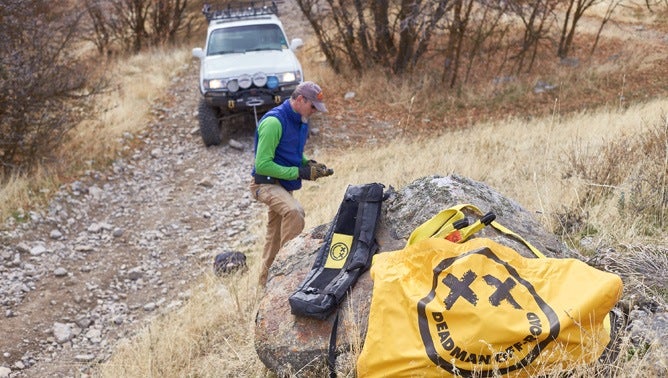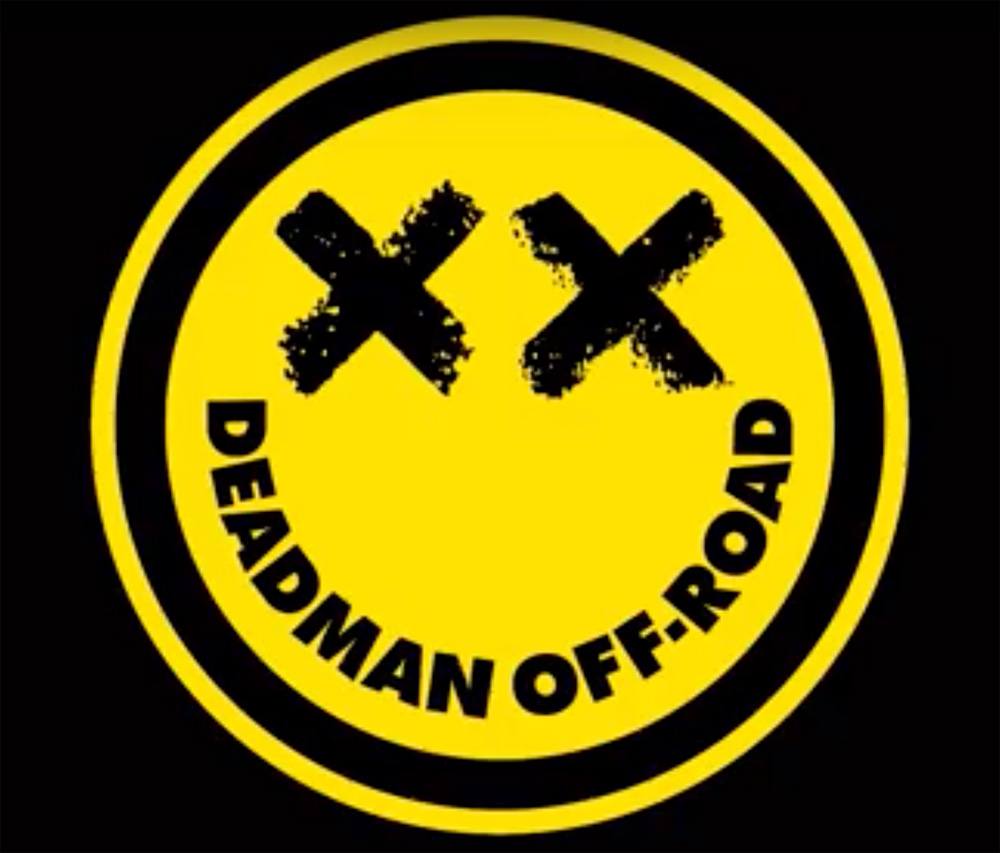I love innovators. Maybe you do, too. It’s fair to say we are living in a modern Renaissance of creativity. Not merely an explosion of brands, this is an unprecedented era of new inventions and new funding for inventors. As a result, it’s an era in which consumers struggle to even hear about all the cool new gear, let alone find the truly innovative ones. For me, one of the best ways to find groundbreaking gear is walking aisle after aisle of vendor booths at trade shows like Outdoor Retailer, Overland Expo and SEMA.
(Lead photo by Andrew McAllister Imaging)
In 2000, just such a product caught my eye. Called the Pull Pal, it offered a unique solution for winching – providing a self-burying anchor – and led to my first product review. That original Pull Pal is still in our quiver of recovery devices, and is still on the market. But two decades later I can tell you that despite its simple effectiveness, the bulk of that tool (35lb+, 45” long) means it’s often left behind on trips.
Last May, as the Overland Expo West was winding down and I’d finished teaching classes, I finally got a chance to go searching out new gear. In the process I came across a small booth with numerous screaming yellow items, and an unmistakable logo. The Deadman Off-Road display stopped me cold. With my photographer/co-instructor/travel partner already hauling tail north out of Flagstaff, I had only minutes to hear the product pitch of the Deadman Off-Road Earth Anchor.
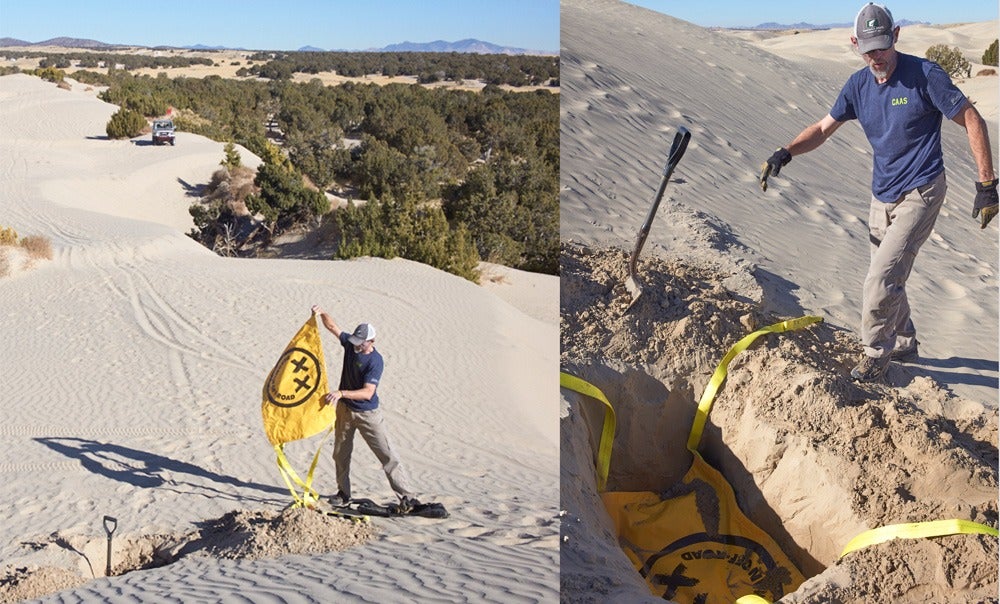
Table of contents
Ancient Idea / New Strategy
Bryant White introduced himself, and began sharing about the Deadman Off-Road mission: create a multi-purpose land anchor that’s light, portable and versatile. Hmmm…”Ok, tell me more”. That conversation not only put me miles behind my northbound colleague, it intrigued me. The groovy Deadman graphics had caught my eye, but the former NASA engineer’s explanation made me realize the product was much more than its flashy (and funny) logo implied.
Despite today’s burgeoning winch market, innovations in winch anchors have basically been forgotten since the Pull Pal. This may be a result of most winches rarely being unwound, and so not needing an anchor. More likely, the problems were simply ignored. The Deadman Earth Anchor, however, was born out of a desire to tackle a solution. Its design emphasizes light weight, ease of setting/removal, versatility and ease of packing. At 8.5 pounds (w/ bag), the soft, stuffable Deadman kit isn’t going to be left in your garage. It safely packs into a vehicle’s cubby spaces, or can be left in its zippered-opening Bodybag, durably made from industrial vinyl and webbing and sewn with tough love by the gang at Blueridge Overland Gear (BROG).
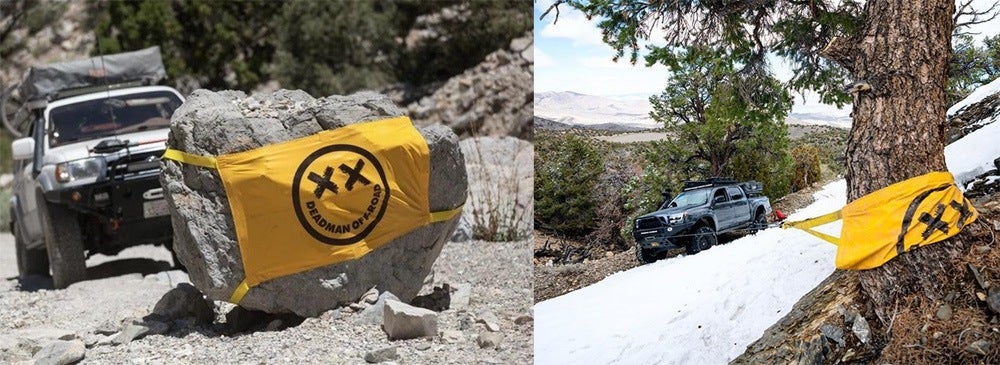
In fact, the entire Deadman line of products is guaranteed “Made in the USA.” Tuff Products in Chula Vista, CA sews up the Deadman itself. Scully Offroad products in California makes the two featherlight soft shackles (4oz ea) offered as part of the kit, each consisting of Dyneema and rated at over 30,000lb, as well as the simple yet versatile Deadloop rigging slings.
Patriotism aside, the value of American-made recovery gear lies in quality, trustworthy safety ratings, and warranties. With innumerable Chinese knock-offs flooding the 4×4/overland market, reliability outweighs saving a few dollars. Deadman provides product failure data based on its testing, coupled with ample built-in safety factors.

The Deadman’s #1 function is offering a solid anchor in even the most sugary sand. While it will work equally well in other soils, sand is where its abilities shine. Using principles of physics, the anchor creates resistance via the mass of material that your winch must effectively lift from the hole you shovel out. Thanks to its unique four-strap system, the 48” x 28” vinyl surface captures a massive amount of ballast that your winch thimble or hook connects to.
Physics + Functions
To understand the results, first give sand some credit. At 100 pounds per cubic foot, even dry sand isn’t light. Add another 30 pounds when sand is damp, like on a beach or in damp regions, and the Deadman lies beneath a 800-1000-pound load per foot of depth. If you do the math, however, even a 3’ hole doesn’t yield a huge mass. So how does Deadman create the necessary resistance?
The magic comes in how the strapping system nets a substantially higher resistance factor thanks to how that “dead load” resists being budged upward AND laterally. In short, the mass above the Earth Anchor is being held back by the adjacent unbroken soil/sand. How effective is it? At the most extreme, we have winched a 6,200-pound Land Cruiser, with tires purposely sunk a foot into sugar sand, up a 30+ degree slope with not a hint of movement from the Deadman. The Cruiser was in neutral, and not aided by the driveline.
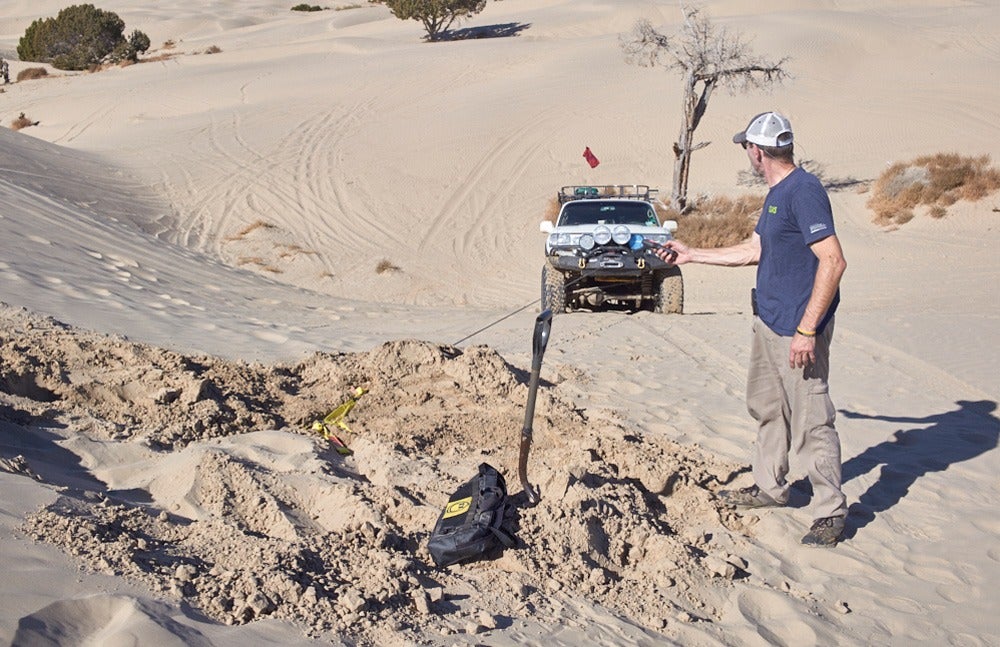
Unlike dirt or gravel, sand shovels very easily. As a result, one person with a standard shovel can place the Deadman in a matter of minutes. Depth of the needed hole depends on several factors (e.g., vehicle weight, slope, surface rolling resistance, if vehicle is operable), but typically only needs to be 24-36” deep. The Deadman Off-Road web site offers superbly clear, well-illustrated explanations for usage in each of the three modes: buried, “tree snuggler” or “rock hugger”.
However, proper use of the Deadman’s straps, which protrude above the surface, is essential. Thankfully, it’s also very, very simple. The engineered rigging of those four straps produces the essential resistance to the anchor moving. Alternately, however, attaching your winch line to only one of the Earth Anchor’s strap serves to slip the anchor out from underground. Through this approach, you’re saved any further shoveling, as the winch doubles as the tool that now easily extracts the Deadman. This process is almost magically simple, and has the added benefit of cleanly leaving all sand/soil in place.
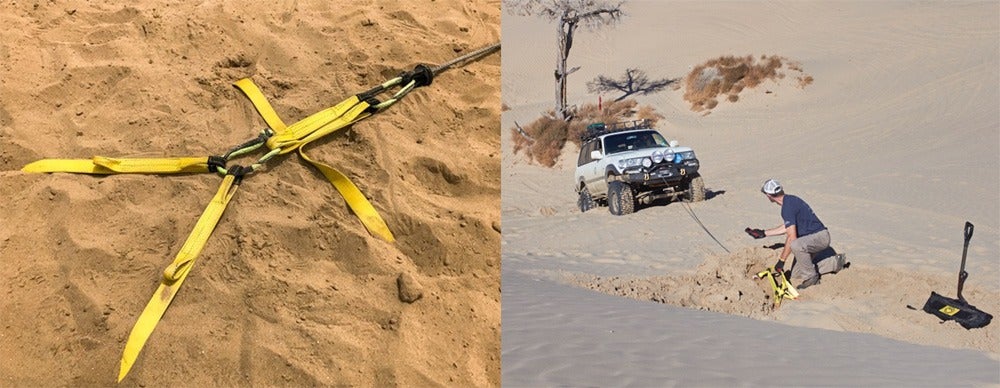
As innovators will tend to do, Bryant, his partner Daniel Norwood, and their team designed in other functional uses to the Earth Anchor as well. Need a winch extension? The Deadman is rated to 19,600 pounds for each strap (15’ max length; straight pull configuration). Similarly, the materials they spec’d resist tearing, allow redundancy, and provide excess capacity while resisting moisture. In the case of the 18oz vinyl, its added benefit is a waterproof surface on which to lay when kneeling or laying on the ground doing vehicle repairs.
Deadman doesn’t brag about it (and that’s a shame), but an array of other uses for the anchor exist. Here are just a few we have found:
- Dragging/winching boulders off the trail
- Grill/radiator covering for deep water crossings
- Tarp for carrying messy cargo (e.g., muddy dogs, field-dressed whitetail, trail trash)
- Small sun shade
- Hanging chair/mini-hammock
- Impromptu snow “sled”
- Seat protector
- Wash basin/rainwater catchment
- Homing beacon to find your campsite at Overland Expo (sadly, not a problem this year)
While none of these are the Earth Anchor’s real intent, they’re reminders that great gear often functions in ways its designers hadn’t envisioned.
Uniqueness aside, is the Earth Anchor finding industry support? The evidence suggests it is. In North America, participants in the Rebelle Rally have been using Deadman products for the past four years. Leading professional 4×4 trainers, including Off-Road Consulting and the international team of 7P Overland, regularly use their products in classes and demos.
Since we began testing the Earth Anchor, Deadman Off-Road has released several new products, including a set of “ruggedized” equipment, featuring wear-protected webbing, protective-layering on the soft shackles, and a tougher Bodybag for storing it all. The result is a really beefy kit for helping your winch do its job when a vehicle to anchor off of isn’t possible and natural anchors are abrasive.
Our Final Verdict
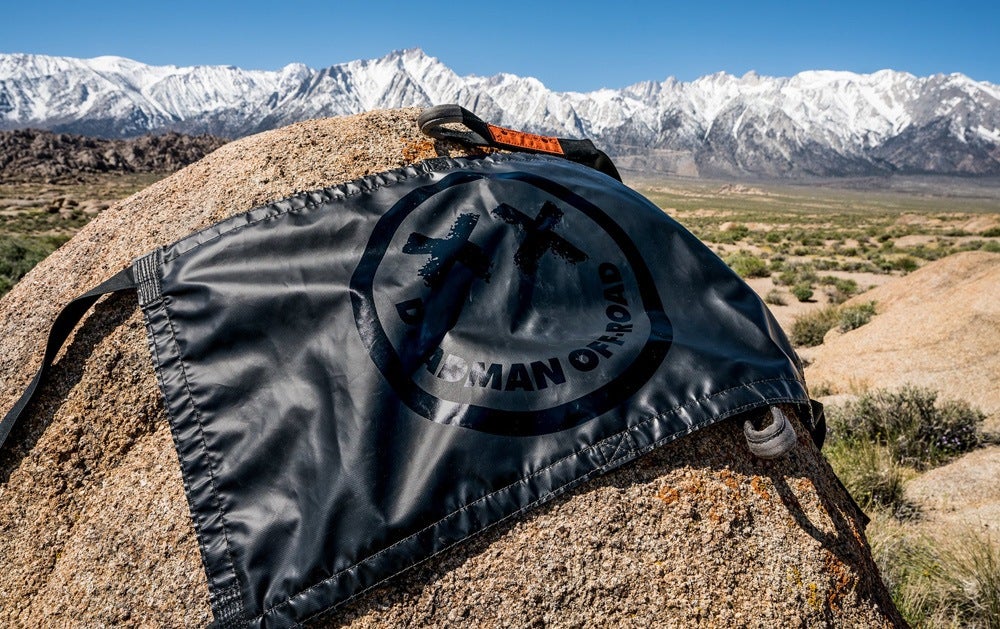
A winch without an anchor point is just more weight sinking your rig. Despite this fact, for decades off-road companies – including winch manufacturers – haven’t tackled the need for anchors. Until now. Deadman Off-Road has brought to market an easy to use, multi-functional anchor that works above and below ground. Conceived, engineered and sewn in America, Deadman products show that innovation is far from deceased in the off-road market.
Because it can double for numerous other recovery and non-recovery uses, Deadman’s Earth Anchor isn’t likely to sit unused like that never-has-been-unbolted Hi-Lift. Thanks to these multiple functions, Deadman has created a winch accessory that can replace other gear (e.g., tree saver straps). Compact, lightweight, and easy to deploy, its main limitation is the adventurer who’s not accustomed to having such a tool.
What’s next from Deadman? The company says it is currently in product development for a new “bigboy version” of its Earth Anchor. Engineered to meet the enormous forces required in winching out commercial-chassis overland vehicles, such as Earthroamers, LMTV-based builds and Unimogs, the new anchor targets a breaking strength of ~100,000 pounds. With an anticipated working load limit of 22,000 pounds, and a release date near the end of 2020, Deadman’s next innovation sounds like essential gear for the largest 4×4’s, and those who tow off-road trailers.
About the Gear Doctor: Dr. Sean Michael has been designing, abusing and testing outdoor gear since the 1980’s, and began reviewing products for Off-road.com in 2000. Today, he is Professor of Outdoor Product Design & Development at Utah State University, a product consultant, and a frequent Instructor at Overland Expo. When not in a Land Cruiser, he explores the West atop a 1200GSA. Follow his trips and gear (ab)use @thegeardoctor on Instagram.
